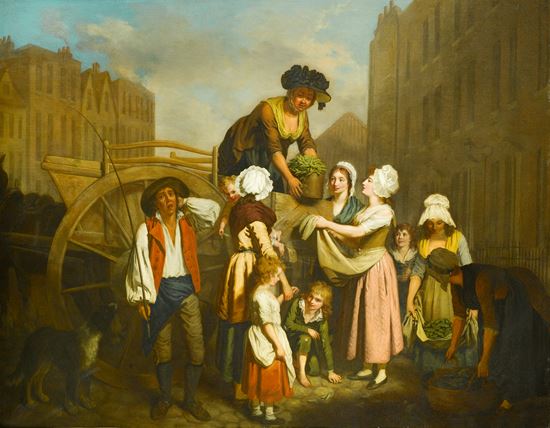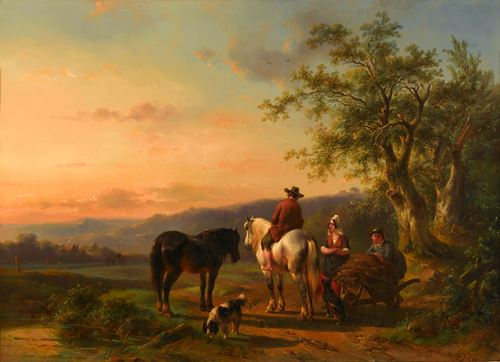rancis Wheatley, R.A.
(London 1747 - London 1801)
Fresh Gathered Peas
oil on canvas
87.9 x 113 cm (34 5/8 x 44½ in)
Francis Wheatley’s Fresh Gathered Peas shows a woman unloading baskets of peas from the back of a cart. A group of women, who have bought the produce, are preparing their baskets for the journey home, whilst children watch on. The abundant baskets, the young fresh faces of the women and children, and the soft sunlight contribute to this cheerful scene of lower-class urban living. Only the man looks anything other than contented, his evident fatigue suggesting he has driven the cart a long way, resulting in the aching neck he gently rubs.
Fresh Gathered Peas is closely comparable with Giovanni Vendramini’s (1769-1839) etching Fresh Gathered Peas Young Hastings. Vendramini’s work is after a design by Wheatley that was part of a series of paintings, later engraved, called the Cries of London showing itinerant merchants selling their wares or services. The fourteen original paintings were immensely popular when exhibited at the Royal Academy between 1792 and 1795 and included images such as Knives, Scissors, and Razors to Grind or Round and Sound, Fivepence a Pound, Duke Cherries. In both Fresh Gathered Peas and Fresh Gathered Peas Young Hastings, peas are being poured by the vendor into the customer’s apron from the back of a cart. Moreover, in both works, a weary looking man watches on, whilst a child and dog are also present. However, Fresh Gathered Peas is clearly a more refined work, with its street setting, additional figures and adept use of light. The repetition of subject matter is testament to the success and popularity of Wheatley’s images of London life.
The son of a tailor, Wheatley was born in Covent Garden in 1747 and was trained at William Shipley’s drawing school, as well as at the newly established Royal Academy Schools. He also won several prizes from the Society of Artists during the early phase of his career. His early work consists mainly of portraits and conversation pieces, which recall the manner of Johan Zoffany (1733-1810) and Benjamin Wilson (1721-1788), under whom Wheatley may well have studied. John Hamilton Mortimer (1740-1779), his friend and collaborator, also seems to have been an influence, particularly in the rendering of fabrics. In his youth Wheatley suffered financial difficulties due to a gambling problem and a love of the extravagant lifestyle of London high society. In 1779, with the help of a loan from Benjamin West (1738-1820), he eloped to Dublin with the wife of J. A. Gresse (1740-1794), another artist. For four years Wheatley worked predominantly as a portrait painter, although he did complete a number of large-scale paintings depicting contemporary events. On his return however, he began to produce the sentimental genre scenes, inspired by Jean-Baptiste Greuze (1725-1805) for which he is best known, and of which Fresh Gathered Peas is an excellent example. It was while he was in Ireland that Wheatley developed this particular style and his genre scenes of rural Irish life provide ‘one of the most rewarding and appealing vistas on to the daily life of the common people of late eighteenth century Ireland’.¹ Upon his return to England he began to work for the print publisher John Boydell. This commission included producing works for the Shakespeare Gallery that were subsequently engraved and it was illustrations for novels and various genre subjects that formed Wheatley’s lasting reputation, Cries of London being undoubtedly his most celebrated work. John T. Hayes has described ‘the crisp handling of paint, the minute attention to detail in the costume, the lovely delicate tonality’ as typical characteristics of Wheatley’s work.² He was elected as a Royal Academician in 1791, but his last years were plagued by gout and continuing debt.
¹ Kelly, J. ‘Francis Wheatley: His Irish Paintings, 1779-83’, in Adele M Dalsimer (ed.), Visualizing Ireland: National Identity and the Pictorail Tradition, Faber & Faber, 1993, p. 160.
² Hayes, J. T., British Paintings of the Sixteenth through Nineteenth Centuries, Oxford University Press, p. 322.
Francis Wheatley’s Fresh Gathered Peas shows a woman unloading baskets of peas from the back of a cart. A group of women, who have bought the produce, are preparing their baskets for the journey home, whilst children watch on. The abundant baskets, the young fresh faces of the women and children, and the soft sunlight contribute to this cheerful scene of lower-class urban living. Only the man looks anything other than contented, his evident fatigue suggesting he has driven the cart a long way, resulting in the aching neck he gently rubs.
Fresh Gathered Peas is closely comparable with Giovanni Vendramini’s (1769-1839) etching Fresh Gathered Peas Young Hastings. Vendramini’s work is after a design by Wheatley that was part of a series of paintings, later engraved, called the Cries of London showing itinerant merchants selling their wares or services. The fourteen original paintings were immensely popular when exhibited at the Royal Academy between 1792 and 1795 and included images such as Knives, Scissors, and Razors to Grind or Round and Sound, Fivepence a Pound, Duke Cherries. In both Fresh Gathered Peas and Fresh Gathered Peas Young Hastings, peas are being poured by the vendor into the customer’s apron from the back of a cart. Moreover, in both works, a weary looking man watches on, whilst a child and dog are also present. However, Fresh Gathered Peas is clearly a more refined work, with its street setting, additional figures and adept use of light. The repetition of subject matter is testament to the success and popularity of Wheatley’s images of London life.
The son of a tailor, Wheatley was born in Covent Garden in 1747 and was trained at William Shipley’s drawing school, as well as at the newly established Royal Academy Schools. He also won several prizes from the Society of Artists during the early phase of his career. His early work consists mainly of portraits and conversation pieces, which recall the manner of Johan Zoffany (1733-1810) and Benjamin Wilson (1721-1788), under whom Wheatley may well have studied. John Hamilton Mortimer (1740-1779), his friend and collaborator, also seems to have been an influence, particularly in the rendering of fabrics. In his youth Wheatley suffered financial difficulties due to a gambling problem and a love of the extravagant lifestyle of London high society. In 1779, with the help of a loan from Benjamin West (1738-1820), he eloped to Dublin with the wife of J. A. Gresse (1740-1794), another artist. For four years Wheatley worked predominantly as a portrait painter, although he did complete a number of large-scale paintings depicting contemporary events. On his return however, he began to produce the sentimental genre scenes, inspired by Jean-Baptiste Greuze (1725-1805) for which he is best known, and of which Fresh Gathered Peas is an excellent example. It was while he was in Ireland that Wheatley developed this particular style and his genre scenes of rural Irish life provide ‘one of the most rewarding and appealing vistas on to the daily life of the common people of late eighteenth century Ireland’.¹ Upon his return to England he began to work for the print publisher John Boydell. This commission included producing works for the Shakespeare Gallery that were subsequently engraved and it was illustrations for novels and various genre subjects that formed Wheatley’s lasting reputation, Cries of London being undoubtedly his most celebrated work. John T. Hayes has described ‘the crisp handling of paint, the minute attention to detail in the costume, the lovely delicate tonality’ as typical characteristics of Wheatley’s work.² He was elected as a Royal Academician in 1791, but his last years were plagued by gout and continuing debt.
¹ Kelly, J. ‘Francis Wheatley: His Irish Paintings, 1779-83’, in Adele M Dalsimer (ed.), Visualizing Ireland: National Identity and the Pictorail Tradition, Faber & Faber, 1993, p. 160.
² Hayes, J. T., British Paintings of the Sixteenth through Nineteenth Centuries, Oxford University Press, p. 322.





 contact
contact +44 20 7313 8040
+44 20 7313 8040










